Incredible Beef Sinigang
Let’s get into the tangy world of Filipino cuisine with this Beef Sinigang recipe! This one-pot Filipino stew combines tender beef, fresh vegetables, and a rich, tangy tamarind broth that brings out the best of Filipino comfort food.

Do not forget to check out my Chefs Tips and Wine Pairings sections below!
Incredible Beef Sinigang tells a story of the Philippines through its rich flavors, tracing back to a blend of local cooking styles and international influences. At its core, you’ve got tender beef and the unmistakable zing of tamarind—a simple mix that hits the spot every time. Filipino families often put their own spin on it, using different sour flavors like guava or calamansi and tossing in a variety of veggies. This adaptability lets Beef Sinigang showcase the diverse tastes and ingredients found all over the Philippines.
Sinigang has come a long way, from a simple dish to a favorite comfort food. It’s loved because it’s easy to make and great for sharing, really fitting in with how Filipinos enjoy meals together. Plus, the way Sinigang has changed over the years really says something about the Filipino knack for making things work, no matter what.
Beef Sinigang is a Filipino favorite, mixing sour and savory perfectly. It’s pretty straightforward, using fresh ingredients to whip up something delicious. Eating it is like getting a taste of the Philippines, showing off how vibrant and welcoming the place is. More than just food, Sinigang celebrates the Filipino way of life and traditions.
You can take a deeper dive into the history of Sinigang
If you want to skip ahead, you can just Jump to Recipe
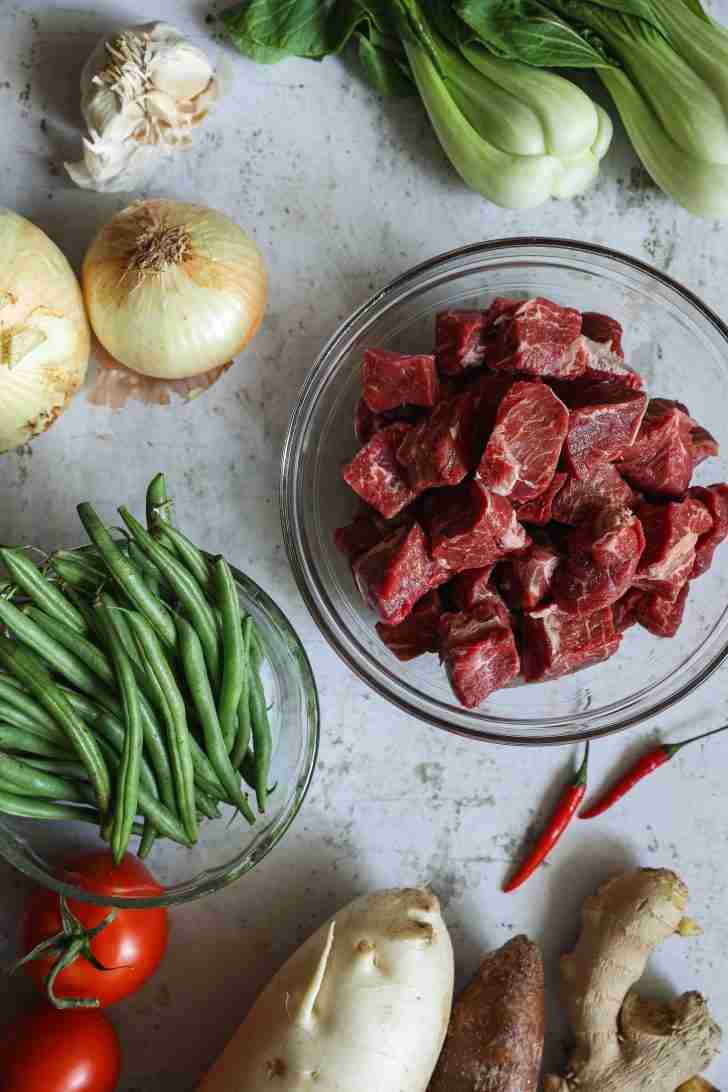
Why this works
- Rich Flavors: When you sear the beef before simmering it in bone broth and adding a bit of vegetable bouillon, you get this incredibly rich base. Searing makes sure the beef stays juicy and flavorful.
- Perfect Sourness: Bilimbi and tamarind paste create the signature tangy flavor that makes this traditional Filipino sour soup so satisfying. It is exactly this balance of sour and savory flavors that transforms this into a hearty Filipino stew this is not easy to resist – at all!!
- Aromatics: Onions, garlic, and ginger add aromatic depth that infuses the broth with layers of flavor. These elements make the sinigang not just tasty but also fragrant. I love this article on Aromatics
- Heat with Balance: The addition of fresh red chilies introduces a mild heat that doesn’t overpower but rather complements the dish’s sour and savory notes.
- Freshness: Tomatoes and bok choi add a fresh, slightly acidic taste and a burst of color. They’re added last to preserve their texture and nutritional value, giving the dish a vibrant finish.
- Easy to Customize: This recipe is fun to customize with your favorite vegetables or by adjusting the sourness and heat to taste. It’s straightforward, making it perfect for both beginners and seasoned cooks.
Remember, you can skip ahead Jump to Recipe
How to make Incredible Beef Sinigang
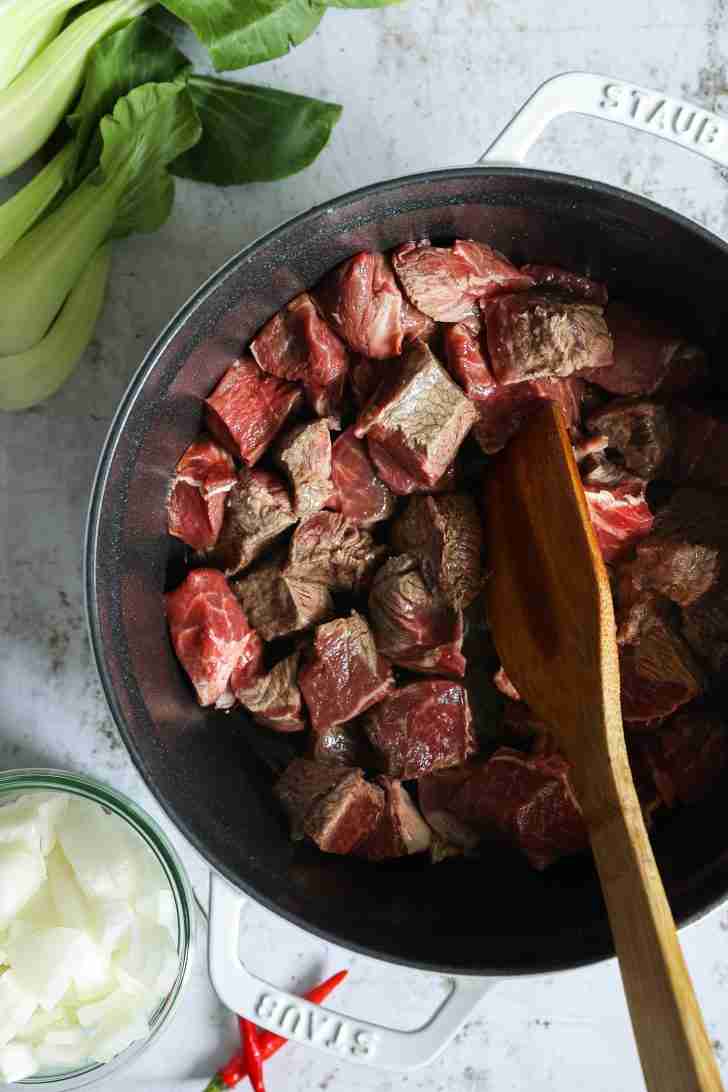
Step 1: Sear the Beef and Start the Broth
- Heat olive oil in a large pot and sear the beef cubes until browned, then set aside.
- In the same pot, sauté diced onions until translucent, then add garlic for a quick sauté.
- Return the beef to the pot, add water and bone broth, and bring it to a boil.
As a quick side note, I have some great info on the Maillard Reaction. That’s what you are doing when you sear!
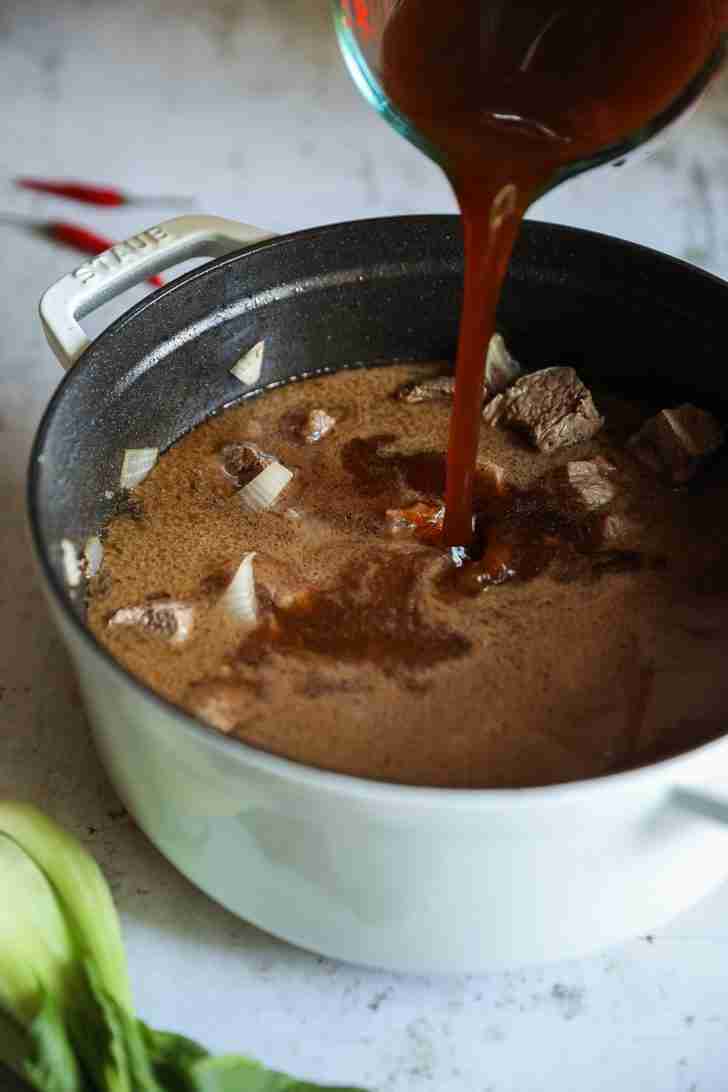
Step 2: Simmer and Add Vegetables
- For an authentic Filipino sour soup recipe, add bilimbi (kamias) and vegetable bouillon, then let this one-pot Filipino meal simmer gently for 45 minutes to an hour
- Add cubed taro and ginger, and continue simmering for another 30 to 45 minutes until the beef is nearly tender.
Why simmer and not boil you ask? This is an excellent article on just that! Why simmer and not boil
Remember, you can skip ahead Jump to Recipe
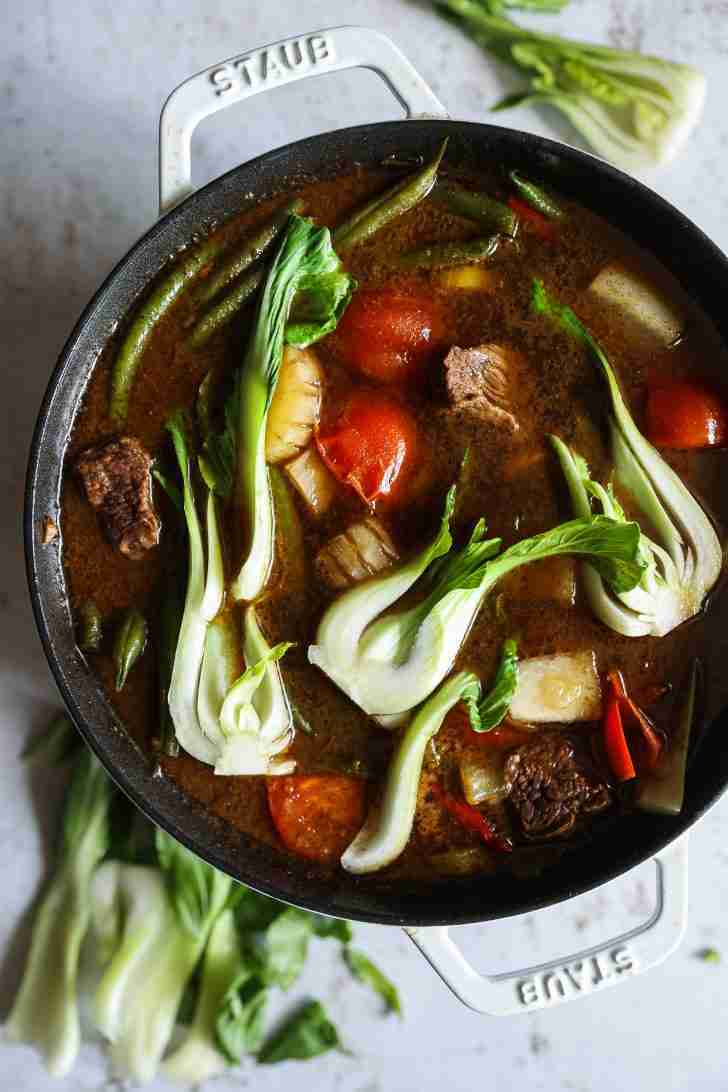
Step 3: Final Touches and Serve
- Stir in tamarind paste, fish sauce, and pepper. Add green beans, daikon radish, chilies, and tomatoes in the last 15 minutes of cooking.
- Turn off the heat, stir in the bok choy, and cover to let it gently cook in the residual heat. Serve with steamed rice!
Remember, you can skip ahead Jump to Recipe
Chefs tips
- Quality Ingredients: Start off with the best beef you can find and freshest veggies. Trust me, the better your ingredients, the more delicious your Sinigang will turn out.
- Sear Beef Well: Don’t rush searing the beef. A good sear adds a rich flavor to the broth. Make sure the pot is hot enough before adding the beef to get that perfect browning.
Balance Sourness: The key of this classic Filipino comfort food is its sour profile. Make sure to taste as you cook to adjust the tamarind for your ideal level of tang. This is YOUR Filipino sour beef soup, so you get to decide!
- Low and Slow: Simmer the beef on low heat to ensure it becomes perfectly tender without falling apart. Rushing this process can result in tough meat.
- Fresh Tamarind: If available, use fresh tamarind to make your broth. It gives a depth of flavor that’s hard to beat. Soak it in warm water, mash it, and then strain the juice for use. Wait until you see the health benefits of Tamarind!!
- Vegetable Timing: Add hardy vegetables like taro and daikon early on but save quick-cooking veggies like bok choi for the last few minutes. This keeps everything at its best texture.
- Fish Sauce Quality: Use a high-quality fish sauce for seasoning. It can dramatically affect the depth of flavor in your Sinigang.
- Serve with Rice: Always serve Sinigang with a side of steamed rice. It’s traditional and helps balance the sourness of this popular Filipino dish.
- Leftovers: Sinigang tastes even better the next day after the flavors have melded together. Don’t hesitate to make a big batch.

Key Ingredients
- Tamarind paste gives Sinigang that signature tangy depth to this Filipino sour soup. It balances the rich beef flavor, making this classic family meal a true taste of the Philippines and a staple Filipino comfort food.
- Bilimbi (kamias) adds another layer of sourness, enhancing the tartness and giving the broth a refreshing, sharp edge that cuts through the richness.
- Bone broth makes the soup base super tasty and rich. It goes so well with the tangy tamarind and bilimbi. Together, they create a really flavorful base!
- Fish sauce introduces umami and saltiness, amplifying the overall flavor of the broth and giving it that unmistakable savory punch.
- Adding Taro (or gabi as its known locally) naturally helps thicken the soup while also giving it a hearty texture, that is just more satisfying.
- Ginger brings warmth and spice, adding a subtle kick that complements the tangy broth without overpowering the dish.
- Daikon radish brings a mild, sweet flavor that helps balance the richness of the broth and the beef.
- Bok choy adds a fresh, light flavor that balances the richness of the beef and broth, with its leafy greens giving a nice finishing touch.
Remember, you can skip ahead Jump to Recipe
Wine Pairings
- Riesling: I know, Riesling with Filipino sour soup? It defiantly sounds a bit unexpected, but trust me, there’s something about the acidity in the wineᅳit grabs onto the broth’s tang like they were made for each other. It’s weird in the best way possible.
- Sauvignon Blanc: If you love crisp acidity and citrus, Sauvignon Blanc is your go-to. Pairing it with Sinigang’s sour broth?It’s the perfect pairing you didn’t even know you needed. Look for one with a good mineral backbone to really stand up to those bold flavors.
- Chenin Blanc: is the secret ingredient you didn’t know you needed!It’s got the right touch of sweetness and enough acidity to really play off the tang. But that is not all: it reveals layers of flavor you didn’t even know existed.
- Grüner Veltliner: Packed your Sinigang with greens? Grüner Veltliner is the perfect match. Its peppery kick and citrusy stone fruit flavors pair beautifully with the herbal and savory notes in the dish.
- Rosé: A dry rosé with vibrant acidity does more than just cut through rich beefᅳit actually enhances the tanginess of the dish. It’s crisp and perfect when you’re looking for something lighter to pair with a hearty meal.
- Pinot Noir: Prefer red wine? Pinot Noir’s your friend. A light-bodied one with bright acidity won’t overpower the dish and pairs delicately with the savory beef.
- Gamay: Another great red option is Gamay. Its light tannins and fruity punch are bold enough to handle Sinigang’s flavors without overwhelming the dish, especially with fattier beef cuts.
Everything you want to know about wine, seriously these guys are amazing!! Wine Folly
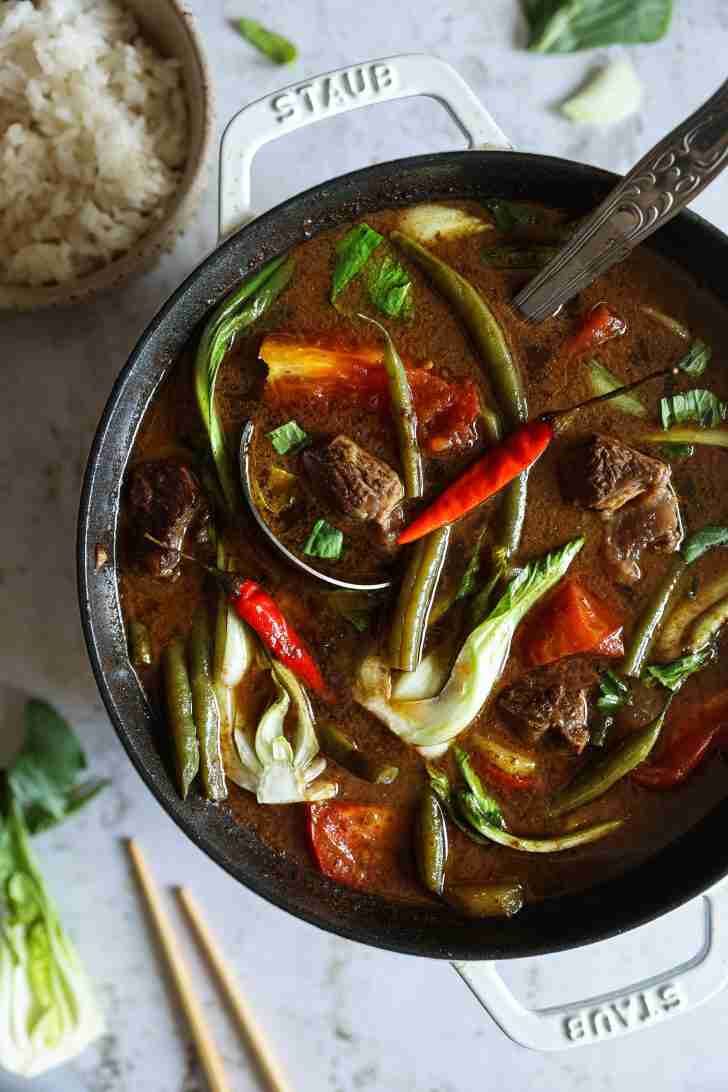
Faq’s
Absolutely! If bilimbi isn’t available, tamarind paste, green mangoes, or even lemon juice can provide that tangy kick Sinigang is famous for.
Rib-eye steak or short ribs work great because they’re flavorful and get deliciously tender when simmered. For a more traditional Filipino stew, brisket or beef shank are also excellent choices!
Adjust the sourness by varying the amount of tamarind paste or bilimbi. Start with a little, taste, and then add more as needed to hit your perfect sour level.
Yes, it can be! If your kids are new to sour flavors, you might start with a milder version. Also, consider the spice level; omit the chilies if necessary.
Definitely. In fact, it often tastes even better the next day as the flavors settle in and deepen. Just reheat it slowly on the stove.
Store it in airtight containers in the fridge. Just remember, let it cool first. Putting it in hot can make your fridge work too hard! It’ll keep well for up to three days or you can also freeze it for longer storage.
Remember, you can skip ahead Jump to Recipe
Equipment Needed
- Make sure to have a large pot on hand, perfect for simmering all the Sinigang ingredients and broth together.
- A good kitchen knife for cutting vegetables and chopping beef effortlessly. It’s pretty straightforward. It makes everything so much easier!
- Having a cutting board is essential for all that chopping and slicing.. Hey using ones for veggies and meat is a smart move to prevent any cross contamination.
- A wooden spoon is great for stirring the Sinigang without causing any scratches on your pot. It’s gentle on types of cookware.
- Don’t forget to have a ladle on hand for serving the Sinigang ensuring each bowl gets a mix of meat, veggies and broth.
- Measuring cups and spoons are necessary for measuring ingredients like water and bone broth as well, as smaller components.
- If you prefer a broth consider using a spoon to skim off any foam that accumulates on the surface while cookingᅳit’s optional but can help achieve that desired clarity.
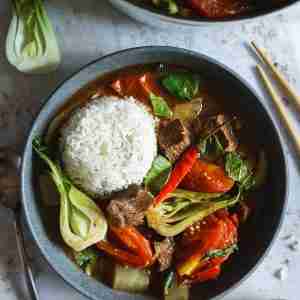
Incredible Beef Sinigang
Ingredients
- 2 tbsp olive oil, For searing the beef and cooking oinions
- 2 lb rib-eye steak or beef ribs (short ribs), cut into cubes, The main protein of the dish.
- 2 medium onions, diced, Adds sweetness and depth.
- 6 cloves garlic, diced, For aromatic depth.
- 4 to 5 cups water, Part of the liquid base
- 4 to 5 cups bone broth, Adds richness and nutrients.
- 10 to 12 pieces bilimbi (kamias), for souring, Provides the signature tangy flavor.
- 1 tbsp vegetable bouillon (to enhance flavor), For additional flavor depth.
- 1 cup cubed taro (gabi), Adds thickness and texture.
- 1 5cm piece fresh root ginger, thinly sliced, nfuses the broth with a spicy, warm flavor.
- 3 tbsp tamarind paste, Contributes to the sour profile.
- 3-4 tablespoons fish sauce, Adds umami and saltiness
- A big pinch of black or white pepper, For a hint of spice
- 1 bunch green beans, tops trimmed, Adds crunch and color.
- 4-5 thick cut pieces daikon radish (labanos), Provides a mild, sweet flavor and crisp texture.
- 2 whole fresh red chilies, Introduces a mild to moderate heat.
- 2 medium tomatoes, quartered, Offers a fresh, slightly acidic taste.
- 2 bunches bok choi, leaves and stalks roughly chopped, Added last for a burst of freshness and color.
Instructions
- Heat the olive oil in a large pot over medium-high. Add the beef and sear until browned. Remove and set aside.
- In the same pot, reduce heat to medium. Add onions, sauté until translucent, then add garlic and cook for another 30 seconds.
- Return the beef to the pot along with water and bone broth. Stir to combine
- Increase heat and bring the mixture to a boil.
- Once boiling, add bilimbi (kamias) and vegetable bouillon. Reduce heat to a simmer.
- Cover and let it simmer until the beef is about halfway cooked, roughly 45 minutes to 1 hour.
- Add the cubed taro and sliced ginger, continuing to simmer until the beef is nearly tender, about another 30 to 45 minutes.
- Stir in tamarind paste, fish sauce, and pepper. Adjust the seasoning to taste.
- In the last 15 minutes of cooking, add green beans, daikon radish, red chilies, and quartered tomatoes. Reserve the bok choi for the final step.
- Once everything else is cooked, turn off the heat. Stir in the bok choi and cover the pot. Allow the residual heat to gently cook the bok choi.
- Serve the Beef Sinigang with a side of steamed rice, ensuring each bowl gets a hearty portion of beef, vegetables, and broth.
